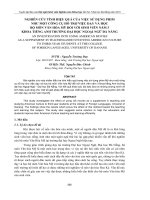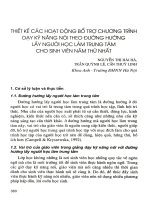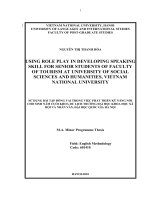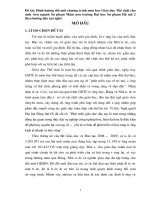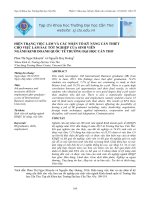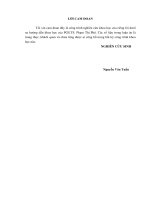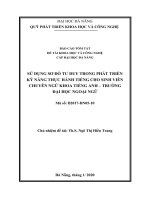thiết kế chương trình dạy kỹ năng viết theo nhiệm vụ kết hợp định hướng phát triển nghề nghiệp cho sinh viên năm hai khoa tiếng anh trường đại học thương mại
Bạn đang xem bản rút gọn của tài liệu. Xem và tải ngay bản đầy đủ của tài liệu tại đây (588.21 KB, 97 trang )
TRƯỜNG ĐẠI HỌC THƯƠNG MẠI
KHOA TIẾNG ANH
NGHIÊN CỨU KHOA HỌC CẤP TRƯỜNG
DESIGNING A TASK-BASED WRITING SKILL SYLLABUS
INTEGRATED WITH WORKING SKILLS FOR THE SECOND-YEAR
ENGLISH MAJORS OF THUONG MAI UNIVERSITY
THIẾT KẾ CHƯƠNG TRÌNH DẠY KỸ NĂNG VIẾT THEO NHIỆM VỤ
KẾT HỢP ĐỊNH HƯỚNG PHÁT TRIỂN NGHỀ NGHIỆP CHO SINH VIÊN
NĂM HAI KHOA TIẾNG ANH TRƯỜNG ĐẠI HỌC THƯƠNG MẠI
Người thực hiện : Ths. Trần Lan Hương
Đơn vị công tác : Khoa tiếng Anh
HANOI, 2017
DECLARATION
I hereby declare that this thesis is a presentation of my original research work.
Wherever contributions of others are involved, every effort is made to indicate this
clearly, with due reference to the literature, and acknowledgement of collaborative
research and discussions.
Signature
Tran Lan Huong
Page i
ACKNOWLEDGEMENTS
I would also like to express special thanks to all the English staff and the secondyear English majors of Thuong Mai University for their contribution to the data
collection and their constructive suggestions for this research.
Page ii
ABSTRACT
The thesis was aimed at designing a practical, feasible and enjoyable writing skills
syllabus for the second-year English majors of Thuong Mai University (TMU). The
study started with the situational and needs analysis based on Hutchinson and Water
(1987). The situational and needs analysis were conducted in TMU with the
employment of the following research instruments: two questionnaires for teachers
and students, and the students’ writing papers, the CEFR (2001) and the current
writing skills syllabus. The informants of the study include all 62 second-year
English majors and 10 teachers of English major section in TMU.
The results of the situational and need analysis show that there is no separated
textbook and syllabus to meet the needs of both the university and the students in
terms of its objectives and contents. The new sets of objectives which emphasize the
communicative competence of the learners in their desirable target situations were
re-determined in accordance with their needs. To best serve the objectives of the
course and learning style preferences of the students, task based was chosen as the
approach driving the design of the new syllabus in which the target tasks in four
main domains: the personal, the public, the occupational and the educational were
derived from the target needs analysis and selected to suit the current level of the
learners (CEF A1+ -A2).
Page iii
TABLE OF CONTENTS
DECLARATION........................................................................................................ i
ACKNOWLEDGEMENTS...................................................................................... ii
ABSTRACT............................................................................................................. iii
TABLE OF CONTENTS........................................................................................... i
TABLE OF FIGURES............................................................................................ iv
PART 1: INTRODUCTION..................................................................................... 1
1. Rationale........................................................................................................... 1
2. Aims and Objectives of the study...................................................................... 3
3. Scope of the study............................................................................................. 3
4. Research questions............................................................................................ 4
5. Design of the study............................................................................................ 4
PART 2: DEVELOPMENT...................................................................................... 5
Chapter 1: Literature review.................................................................................. 5
1.1. Approaches to Teaching Writing for Specific PurposeError! Bookmark not defined.
1.1.1. Product Oriented Approaches.................Error! Bookmark not defined.
1.1.2. Process Oriented Approaches.................Error! Bookmark not defined.
1.1.3. Genre Approaches....................................... Error! Bookmark not defined.
1.2. Task-Based Approaches..................................... Error! Bookmark not defined.
1.2.1. Tasks and types of tasks............................ Error! Bookmark not defined.
1.2.1.1. Target Tasks.......................................... Error! Bookmark not defined.
1.2.1.2. Learning Tasks..................................... Error! Bookmark not defined.
1.2.2. The framework of TBLT applied in teaching writingError! Bookmark not defin
1.3. Task-Based syllabus (TBS).................... Error! Bookmark not defined.
Chapter 2: Methodology......................................................................................... 5
2.1 . Setting of the study.................................................................................. 28
2.2 . Informants............................................................................................... 28
2.3 . Data collection instruments..................................................................... 29
2.4 . Data collection and data analysis procedure............................................ 30
Chapter 3: Findings and Discussion.................................................................... 32
3.1. The situational analysis of the teaching and learning context in TMU.....32
3.1.1. The teachers....................................................................................... 32
3.1.2. The students....................................................................................... 32
3.1.2.1. Background................................................................................ 32
3.1.2.2. Writing competence.................................................................... 32
3.1.2.3. Motivation in learning writing skills........................................... 34
3.1.3. The shortcoming of the current writing textbook............................. 34
3.2. Needs Analysis......................................................................................... 36
3.2.1. Target tasks and target language focus perceived by the university
based on the CEFR...................................................................................... 36
3.2.2.Target tasks and learning tasks perceived by teachers and learners....38
3.3. Learning needs analysis............................................................................ 39
Chapter 4: The proposed writing skill syllabus
4.1. Justifications for the choice of task based approach to designing the
syllabus
4.2.
Course description
4.3.
Tasks Selecting and Grading
PART 3: CONCLUSION .......................................................................................
1.
Summary of the study ...............................................................
2.
Limitations of the study ............................................................
3.
Suggestions for further studies .................................................
References ...................................................................................................................
Appendixes ...............................................................................................................
Appendix 1: NEEDS ANALYSIS FRAMEWORK (Hutchinson and Waters,
1987) ........................................................................................................................
Appendix 2: THE STUDENTS’ QUESTIONNAIRES ................................................
Appendix 3: THE TEACHERS’ QUESTIONNAIRES ...........................................
Appendix 4: Written test evaluation criteria (Adapted from CEFR (2001)) ..........
Appendix 5: Sample lesson procedures ................................................................
TABLE OF FIGURES
Figure 1: Framework for task based writing teaching . Error! Bookmark not defined.
Figure 2: Framework for task based syllabus design (Ellis. 2003: 66)Error! Bookmark not def
Figure 3: Framework for task based syllabus design (Nunan, 2004:25)Error! Bookmark not de
Figure 4: Students’ length of time of learning English........................................... 32
Figure 5: The estimated writing competence of the students..................................33
Figure 2: Students’ attitudes toward Writing Skills................................................. 34
Figure 7: The target level for the writing skills after the first semester as required
by TMU ( Based on CEFR( 2001:61,62, 82)........................................................... 37
Figure 8: Teachers' and students' preference for the specific writing tasks............39
Figure 9: The familiar vs. the expected teaching and learning styles......................40
PART 1: INTRODUCTION
1. Rationale
Writing is one of the four major language skills that foreign language
students have to master. It is a common knowledge that writing is very important in
language learning as, according to Rames (1983), writing helps learners not only in
the ways it reinforces learners to practice certain grammar and vocabulary
structures and reflect on why those are used and not others but also in the way it
improves the learners’ thinking skills as when students write, they make effort to
express ideas with constant use of eyes, hands and brain and discover a real need
for finding the right word and the right sentence.
As writing is of such great importance for language learners, teaching how
to write well is the inevitable aim of almost all language courses. Yet, teaching
writing is challenging for language teachers as ‘writing fluently and expressively is
a tough task for all language users regardless of whether the language in use is first,
second or foreign language’ (Nunan,1988:3).
Whether the journey writing teachers and learners have to go on under their
writing course is smooth and whether the learners can reach the destination of the
journey depend on a wide variety of factors such as the course syllabus, the teaching
methodology, the available resources and the motivation of the students. From all
these influential factors, the course syllabus is extremely important because if
appropriately designed with careful need analysis, the syllabus can act as the
guidance for both teachers and learners in terms of aims, the objectives, teaching
methodology, material suggestions, time allocation, assessments, and almost all the
matters of learning and teaching. In fact, a course syllabus can be compared with a
helpful travel guidebook or a compass for teachers and learners in their journey to
knowledge. Especially, a course syllabus plays an absolutely significant role when
writing for specific purposes because it requires a lot of skills which can helps
students meet the requirements from the employers and be ready for their jobs for
their future.
From early 1960s, English for Specific Purposes (ESP) has grown to become
one of the most prominent areas of EFL teaching today and gained a well-
Page 1
established position as a component of applied linguistics research (Dudley-Evans
& St Johns, 1998). As the word “specific” suggests, the nature of ESP is different
from that of general English in a sense that ESP learners learn English for a certain
professional or occupational purpose. Therefore, teaching/learning ESP includes
much more than the teaching of English through specific materials and content. In
fact, it combines the development of linguistic skills together with the acquisition of
specific information. Consequently, to ensure the success of ESP learning, the
materials should be wisely selected and adapted and learning activities should be
carefully designed, and more importantly, an appropriate teaching method should be
adopted.
In the recent years, the ESP movement in Vietnam has been rapidly
developing due to the existence of diverse needs of the learners. Currently, all
university students must learn the ESP that suits their learning branches. For
example, students at economics universities have to learn English for commerce,
while students from the Information Technology universities have to learn English
for IT. However, a lot of questions have been raised over the quality of ESP
teaching and learning at university as many students studying ESP show quite poor
performance on four language skills and a lot of graduates cannot use ESP in their
work. This results in an unsolved problems that ESP teachers are encountering:
How to design appropriate syllabus and authentic learning activities to enhance ESP
learning?
In addition, the fast changing business environment and the ever-growing
demand facing professional communicators in the 21st century pose new challenges
to language learners and teachers alike. Competitive business organizations attempt
to recruit employees who have excellent linguistic competence coupled with
nonlinguistic competences and skills. It is not easy to acquire these additional
competences and skills. However, most of them are transferable and can be greatly
improved if students are provided with adequate teaching materials and appropriate
input from the teacher.
Despite the importance of syllabus in teaching writing for ESP- one of the
most difficult language skills, it is not always given adequate attention to. This is
Page 2
exemplified by the context of teaching writing for ESP in Thuong Mai University
(TMU) where the current used syllabus is available but developed out of the
syllabus writers’ personal experience and intuition without referring to the situation
analysis and learner needs analysis. Consequently, when the syllabus for ESP was
operated, it showed a lot of pitfalls, the greatest of which being the students’
disinterest in learning writing, the irrelevance of the writing tasks and the teaching
methodology. This fact gives rise to the need to design a new business writing
syllabus for second-year students who have already got basic writing skill in The
business Pre-intermediate in the first year and have better knowledge about general
business writing as well as see the importance of the business writing for their jobs
in the future. That syllabus should be based on careful analyses of contextual factors
and learner needs as well as educational needs, i.e., the objectives of the foreign
language program.
The ideas above motivate me to design a new writing skills syllabus for the secondyear English majors at TMU.
2. Aims and Objectives of the study
The study aims at designing a new appropriate writing skills syllabus for the
second-year English majors at TMU.
To achieve this aim, the following objectives are established:
(1)
To develop a theoretical framework related to writing syllabus
design
(2)
To identify the needs perceived by the university, the teachers, the
second-year English majors toward an appropriate writing syllabus for the
target students.
(3)
To propose a writing syllabus based on the relevant theories and the
needs analysis
3.
Scope of the study
The syllabus limits itself to the design of new writing skills syllabus for second-year
English majors in TMU. Thus, it is not intended for other groups of the students at
the University or students from other universities. However, once the syllabus has
been implemented, and evaluated by the university teachers who implement the
Page 3
syllabus, it can serve as a reference for those who are interested in designing a
similar syllabus for similar groups of students.
4.
Research questions
1.
What are the students’ learning needs and target needs from the
perspective of the students, the teachers and the university?
2.
What aims and objectives should be included in the writing skills
syllabus for the second-year English majors?
3.
What contents and teaching methodology should be included and
organized in the writing skills syllabus for the second-year English majors?
5.
Design of the study
The thesis will be comprised of three parts
Part 1 is the introduction, which presents the rationales, the aims, the objectives, the
scope, the methods and the design of the study.
Part 2 is the development which consists of four chapters:
oChapter 1 reviews the literature related to the syllabus design and
the theoretical issues on the definition and features of task based
language teaching in relation to the teaching of writing skills in EFL
context.
o Chapter 2 reports the research methodology the setting, the
informants, the instruments and the data collection and analysis
procedure.
oChapter 3 presents and discusses the findings from need analysis in
light of teaching problems with the current syllabus, the insiders’
attitudes towards writing skills and the current syllabus as well as their
expectations of the changes in teaching and learning writing skills. In
addition, a new task-based syllabus is proposed based on the findings
of the research.
Part 3 is the conclusion that provides a summary, state the limitations of the study
and give some suggestions for further research on the topic.
Page 4
PART 2: DEVELOPMENT
CHAPTER 1: LITERATURE REVIEW 1.1.
Approaches to Teaching Writing for Specific Purpose
English for Specific Purposes
Teaching English for Specific Purposes (ESP) is a prime illustration of the
saying “what comes in time, changes over time.” ESP as a term came into language
more than 50 years ago. The notion of a language for specific job-related purposes
appeared in the sixties and the early seventies of the 20th century and was
connected with the pioneering research of Halliday, MacIntosh and Strevens (1964).
Since its introduction ESP has been changing and developing all the time, and it is
expected to change and develop in the future as well.
Widdowson (1983:10) is of the opinion that “ESP is simply a matter of
describing a particular area of language and then using this description as a course
specification to impart to learners the necessary restricted competence with this
particular area.” Hutchinson and Waters (1987:19) support the idea that ESP must
be seen as an approach, rather than a product.
According to Hutchinson and Waters (1987:5), there were three main reasons
for the emergence of all varieties of ESP: the demands of the New World after WW
II, a revolution in linguistics, and a focus shift from the teacher to the learner
(Hutchinson & Waters, 1987; Dudley-Evans & St. Johns, 1998). English became
subject to the wants, needs, and demands of people other than language teachers. It
was the learner who explicitly called for courses tailored to meet their professional
needs.
A significant discovery at that time was that the ways in which we speak a
language and write in a language vary. The significance of this discovery was that,
as a result of these variations in language use, language teaching could be tailored to
both spoken and written professional situations.
In the late 1960s and the early 1970s, there were first attempts to teach
English for Science and Technology (EST). It was the first variety of language for
specific purposes that received scientific attention. Hutchinson and Waters (1987),
Swales (1980), and Selinker and Tarone (1981) were among the EST pioneers.
Page 5
Another significant discovery came from the psychology of learning –the
research showed that another focus shift was needed, that from language delivery to
language acquisition (Hutchinson & Waters, 1987). Focus on learners’ needs
became as important as the methodology of language teaching. Designing courses
that could best meet these needs was bound to be a success.
According to the definition given by Hutchinson and Waters (1987:19), “ESP
is an approach to language teaching in which all decisions as to content and method
are based on the learner’s reason for learning.” It was a real revolution in language
teaching – from a teacher-centered approach to a learner-centered and learningcentered approach, a milestone in language teaching that had its repercussions for
the decades to come.
In 1983, Carter distinguished three varieties of ESP: English as a restricted
language, English for Academic and Occupational Purposes, and English with
specific topics. The famous “tree of ELP” (Hutchinson & Waters,1987) shows that
ESP was subdivided into English for Science and Technology (EST), English for
Business and Economics (EBE), and English for Social Studies (ESS). Each of
these three varieties was further subdivided into EAP and EOP. Now ESP is an
umbrella term which includes English for Science and Technology, English for
Academic Purposes, English for Business and Economics, English for Management,
English for Medicine, English for Finance and Banking, English for Law, English
for Tourism/Engineering/Accounting, etc.
The number of ESP dictionaries reflects the creation and development of
each variety of ESP. By analyzing the year of publication, the type and the number
of ESP dictionaries on the market, we can make conclusions on the popularity of
each ESP variety. In the 1980s and 1990s, about 80 new ESP dictionaries (mostly
technical) appeared on the Polish market, and during the period 1990–2006 there
were more than a hundred new business dictionaries available in Poland. It
demonstrates the popularity and expansion of ESP.
Today we can witness that publishers not only offer course-books and on-line
materials for the varieties of ESP presented above but also publish books and
materials targeted at a single profession, e.g. English for Nurses, English for Job
Page 6
Hunters, English for Beauticians or Air Speak (English for Air Traffic Controllers).
The variety of course-books on offer shows that there is a huge demand for highly
specialized language courses.
At the early stages of ESP teaching, courses were aimed mainly at
specialized linguistic competence. In the 1970s, specialized terminology and
functional language were regarded to be the priorities in ESP courses.
Courses were, to a great extent, language-oriented, and their main aim was to
teach specialized lexis and grammar. In the mid-1970s and 1980s, a new approach
to teaching business English appeared – it was the communicative language
teaching approach focused on communication in typical professional situations.
With time the priority of linguistic competence was replaced by the priority of
communicative competence, and communication skills became target number one in
ESP.
In Europe, the 1990s were the decade when the following important
innovations were introduced: the euro, financial deregulation, and venture capital.
Throughout the world, globalization processes brought greater job mobility and
international cooperation. It was also the time when new communication
technologies became more accessible worldwide: the Internet and mobile phones
have significantly facilitated and sped up communication. All these changes have
had a strong impact on learners’ needs. Successful ESP courses imply that coursebook authors cater for future real-life needs of learners, especially in the case of preexperienced adult students, who may not fully realize what language competence
their future job will require of them. Target situations, in which they will have to
communicate effectively, have to be examined (as part of needs analysis) and
considered when designing a course-book.
A learner-centered approach adapted in ESP courses has allowed for the
following developments in language teaching:
– inclusion of materials into a syllabus is based on the learners’ reasons
for learning,
– courses are more intensive – learners want to achieve good language
competence in the shortest time possible,
Page 7
– learners can negotiate the syllabus,
– learning is understood as an active construction of meaning,
– teaching is perceived as guiding, scaffolding, and facilitating learning,
– real-life tasks are prioritized,
– meaningful and purposeful interaction can be created through language,
– tasks are cognitively more challenging,
– learners have more autonomy,
– learners accept more responsibility for the outcome of the learning process,
– making vocabulary personal helps to make it more memorable (McCarten,
2007).
Today we can still witness that demand for English for Specific Purposes
continues to increase and expand throughout the world (DudleyEvans, 2001).
Learners need courses matching their ever growing needs and requirements
resulting from what the labour market demands.
English for Specific Purposes (ESP) is divided into English for Occupational
Purposes (EOP) and English for Academic Purposes (EAP). It aims to prepare
students, in a relatively short period of time, to communicate, read, and write better
so they can work appropriately and successfully in certain activities. In order to
achieve this goal, ESP activities have to be presented in context because context is
the central idea of ESP. The other point that has to be taken into consideration in
teaching ESP is to use authentic materials; this will lead the students to acquire
what they need to develop for their jobs (Hutchinson & Waters 1987). According to
Dudley-Evans (2001), the absolute characteristics of ESP are:
•
•
ESP is designed to meet the specific needs of the learners.
ESP makes use of the underlying methodology and activities of the
specialization it serves.
•
also
It is centered not only on the language (grammar, lexis, register), but
on the skills, discourses and genres appropriate to those activities.
English for Occupational Purposes (EOP)
English for Occupational Purposes is a branch of ESP (English for Specific
Purposes) and covers situations in which learners are studying English for work
Page 8
related reasons. EOP can be grouped into business English, professional English
(e.g. English for doctors, lawyers) and vocational English (e.g. English for tourism,
aviation, and nursing).
Several studies (Flanegin and Rudd, 2000; Goffman, 1979; Pakir, 1999,
Puvenesvary, 2003) have been conducted on the importance of English in the
occupational fields.
Flanegin and Rudd (2000) discuss the need and importance of English skills
in all professions. In addition, they emphasize on the importance of communication
skills in the business and management fields by suggesting some solutions to enable
students to be good communicators in business majors. Goffman (1979) indicates
that business negotiations are carried out and letters are usually written in English.
This sometimes discomforts those whose first language is not English. The use of
English is even more widespread because of the business-environment revolution.
In fact, Pakir (1999) points out that the spread of English is most likely to continue
because of the rapid spread of telecommunication, mass communication, business,
and internet links. Thousands of international non-native to non-native
communication and deals are undertaken daily in a huge number of settings: trade,
diplomacy, tourism, journalism, science and technology, politics etc. As a result,
there is a need to ensure there are competent writers and speakers of English.
Puvenesvary (2003) reveals the importance of being a competent writer of English
in the banking sector in Malaysia and the consequences of poorly-written business
letters to clients.
The five key stages in EOP teaching include needs analysis, course (and
syllabus) design, materials selection (and evaluation), teaching and learning, and
evaluation. Among these, needs analysis is the very first and perhaps the decisive
factor in the success of any EOP courses. According to Johns, while teaching EOP,
“all language teaching must be designed for the specific learning and language use
purposes of identified groups of students.”(Johns, 1991, p.67) Teaching EOP is
therefore determined by different - professional/ occupational, social and other needs of the learners. In Nunan’s view, needs analysis is the initial process for the
specification of behavioral objectives. It is from these objectives that detailed
Page 9
aspects of the syllabus such as functions, topics, lexis and structures are derived.
Dudley-Evans and St John believe that it is the “corner stone of EOP and leads to a
very focused course” (p.122). Likewise, in a definition of ESP course, Hutchinson
and Water (1987) state that EOP is an approach to language teaching which aims to
meet the needs of particular learners. Richards (1984) also points out the
significance of NA as follows:
“Needs analysis serves three main purposes: it provides a means of
obtaining wider input into the content, design and implementation of a language
program; it can be used in developing goals, objectives and content; and it can
provide data for reviewing and evaluating an existing program.” (p.5)
Dudley-Evans and St John in their “Development in ESP” (1998) suggest
that needs analysis can be done through a variety of means such as pre-course
information questionnaires, structured interviews, observation, analysis of authentic
texts, discussion, and record-keeping. These suggested methods have their own
strengths and weaknesses but if utilized appropriately, they can provide useful and
reliable data for the process of needs analysis. Hopefully, with a smooth beginning,
the whole EOP course will run successfully.
The target needs: Before designing a course, students should know why they
are taking the course and how they will apply that learning. Also English language
teachers should know what kind of tasks and activities learners will be using
English for (Kandil, 2003). Hutchinson, and Waters, 1987 suggested the following
questions as a start-point to uncover relevant information.
Why is the language needed?
How will the language be used?
What will the content areas be?
Who will the learners use the language with?
When/Where will the language be used?
(Hutchinson, T. and Waters, A 1987, pp 59).
The learning needs: The learning needs refer to the learners’ language
difficulties, their learning objectives, their styles of learning etc (Jolly.and
Page
10
Bolitho.1998). It is the starting point or the route and answers the question. To
understand the learning needs we should find answers for the following questions.
Why are the learners taking the course?
How do the learners learn?
What resources are available?
Who are the learners?
When/Where will the course take place?
The new educational pedagogy emphasizes the importance of the learners
and their attitudes to learning (Hutchinson, and Waters, 1987, pp 59). Satisfying
learners’ needs and interests has an important influence on the learners’ motivation
and therefore achievements. Moreover, this approach gives learners the opportunity
to participate in the syllabus design. In a context where the nature of the work
changes, and the linguistic needs change too, the importance of this approach
increases. As Mackay and Mountford (1978) stated, adults who need English for
academic or professional purposes are more aware of what they want to use English
for.
In fact, the results of a needs analysis are not absolute but relative. There are
a number of factors that could affect the outcomes: for instance: who to ask; what
the questions are; and how the responses are interpreted (Dudley-Evans and St. John
1998) .
Methodologies for Teaching Writing for Occupational Purposes
Prior to discussing the theories related to writing for occupational purposes, a
few studies will be highlighted in relation to writing problems (Arndt, 1987; Badger
and White, 2000; Davies, 1988; Hyland, 2003; Jordan, 1997; Kambal, 1980; Myles,
2002; Paltridge, 2001; Silva, 1990; Smith, 1982; Swale, 1990; Tribble, 1996;
Vygotsky, 1978; and Zughoul and Husain, 1985).
Kambal (1980) analyzed errors in three types of free composition written by
first year Sudanese university students. The study took into consideration the major
syntactic errors made by these students in the verb phrase and the noun phrase.
Also, Kambal (1980) reported that the three main types of errors made in the verb
Page
11
phrase are verb formation, tense, and subject-verb agreement. He discussed errors in
tense within five categories: tense sequence, tense substitution, tense marker,
deletion, and confusion of perfect tenses. The findings of this study reveal that the
third-person singular marker was used redundantly, and they also revealed the use of
the incorrect form of verb to be.
Zughoul and Husain (1985) point out that the lack of lexical variety,
subordination, and their heavy reliance on redundancy that does not add any new
information to the text are the main problems learners have in writing skills. As a
result, L2 practitioners are still in search of a coherent, comprehensive theory of the
teaching of writing. The major writing theories proposed in the literature are
product, process, and genre.
According to Raimes (1983), there are 3 principal ways of approaching the
writing task: focusing on form, focusing on the writer, focusing on the reader. The
first perspective can be found in traditional, text-based approach or product oriented
approach in other words. Teachers who adopt this approach often present
authoritative text for students to imitate or adapt and they may see errors as
something they have a professional obligation to correct and eliminate (Tribble,
1996: 37). The second approach which is called “process approach” emerges in part
as a reaction against the tradition of form- focus. It particularly stresses on the
writers as an independent producers of text. The third approach called “genre
approach” is considered to be more socially oriented with the assumption that if the
reader cannot recognize the purpose of a text, communication cannot be successful.
1.1.1. Product Oriented Approaches
According to Brown (2000), product-oriented approaches to writing largely
concern the forms of the written products that students compose. The writing
exercises applied in this approach typically deal with sentence-level writing and
paragraph-level organization. Students are often given a framework which
illustrates a pattern of rhetorical organization; then, they are asked to fit their ideas
into this framework. Both the content and the form which the students deal with are
largely controlled by the teacher. Since the main focus of these approaches is on
written form, grammar is emphasized and a particular effort is made to avoid errors.
Page
12
1.1.2. Process Oriented Approaches
Dissatisfaction with controlled composition approach paved the way for the
process approach, an ‘expressive approach’ which became prominent in Englishspeaking composition classrooms during the 1980s. Process approach encourages
students’ communication of ideas, feeling and experiences (Steele, 2002). Process
approach focuses more on the various class activities which are believed to promote
the development of skilled language use. With the process approach, writers are
encouraged to get their ideas on paper in any shape or form without worrying too
much about formal correctness. It also encourages collaborative group work among
students as a way of enhancing motivation and developing positive attitudes
towards writing. Moreover, process approach encourages the development of
critical thinking skills, which help them to have chances to challenge their social
reality (Nunan, D, 1991: 87).
1.1.3. Genre Approaches
Genre Based approach has become popular since the 1980s along with the
notion that student writers could benefit from studying different types of written
texts. (Yan, 2009). To begin with, genre-based approaches start with the whole text
as the unit in focus rather than the sentence. The focus on the whole texts implies
that there is higher level of order and patterning in language than just in sentencegrammar at the level of discourse organization and meta-patterning of grammatical
features. Genre –based approaches emphasize that this higher order must be
attended to for effective language use. The specification of genres to be taught is
based on the classification used by many systemic functional linguists, especially in
application to classroom teaching of English (Lin, 2006).
Genre approaches have strong similarities with product approaches, and in
some ways, genre approaches can be regarded as an extension of product
approaches. Like product approaches, genre approaches regard writing as
predominantly linguistic but, unlike product approaches, they emphasize that
writing varies with the social context in which it is produced. As a result, there is a
range of kinds of writing-such as sales letters, research articles, and reports - linked
with different situations (Flowerdew 1993: 307).
Page
13
1.2. Task-Based Approaches
Apart from the three mainstream approaches above, there is also an approach
namely TBLT that is rather slippery to be classified into either product oriented,
process-oriented or genre approaches as it is kind of selected combination of all to
serve the purpose of enhancing communicative competence with target language.
For that reason, task based approach in this paper is discussed in a separated part.
Although the approach known as ‘task-based language teaching’ (TBLT) has
already emerged since mid 1980s with Long & Porter (1985), Nunan.D (1989) and
flourished with a lot of research done honors the names of Candlin , Crookes,
Skehan, Willis, Ellis and many other scholars of ELT, little research has been
concerned with teaching writing in particular except for Yoshito, S. (2009) and
Setyaningrum, Z.(2011). However, none of these two studies suggests any definition
or framework for TBLT for teaching writing skills. Therefore, task based writing,
like other language skills, in this studied, is discussed mainly based on the general
framework for TBLT in general.
Accordingly, TBLT approach to teaching writing seeks to engage learners in
interactionally authentic language writing by having them perform a series of tasks.
It aims to both enable learners (1) to acquire new linguistic knowledge and (2) to
proceduralize their existing knowledge (Ellis, 2003).
1.2.1. Tasks and types of tasks
Willis, J. (1996:23) defines ‘tasks are always activities where the language is
used by the learners for the communicative purpose (goal) in order to achieve an
outcome.’ More clearly, according to Ellis (2003), a task is a work plan that requires
learners to process language pragmatically in order to achieve an outcome that can
be evaluated in terms of content (rather than language). In these two definitions,
tasks are seen in the pedagogical perspectives only.(Nunan, 2004).
Nunan, (2004) refers the definition of tasks in Ellis (2006) as ‘definition of
pedagogical tasks’ (Nunan, 2004:3) and gives his own definition in terms of two
tasks: real world tasks and pedagogical tasks which are called target tasks and
pedagogical tasks by Long, & Crookes (1992) and communication tasks and
learning tasks by Breen (1987, 2) respectively .
Page
14
The two terms Target Tasks and Learning Tasks are used instead in this
study.
1.2.1.1. Target Tasks
Target tasks are the things people do in their real life. Thus, examples of
target tasks including filling a form, dressing a child, buying a pair of shoes, writing
a cheque, etc. ( Long & Crookes, 1992)
1.2.1.2. Learning Tasks
Learning tasks are pieces of classroom work that involve learners in
comprehending, manipulating, producing and interacting in target language while
their attention is focused on mobilizing their grammatical knowledge in order to
express meaning rather than manipulate forms. (Nunan, 2004)
Therefore, a controlled practice activity involving repetition of target
patterns is not a task, even if this is done in pairs. For example, the activity of
changing the verb forms from present to past simples or in pairs ask and
answer question using Do you like ….?Yes, I do, No, I don’t. (Willis, J., 1996)
In short, tasks draw the attention paid on meaning while a controlled practice
activities or exercises are focused on forms. That tasks are meaning focused does
not mean that forms are not important, but it means forms can be learnt
simultaneously through the process of task completion.
1.2.2.
The integrated EOP framework of TBLT applied in teaching writing
It is well-known that an EOP course design includes the following elements:
needs analysis, objectives, means, syllabus, methodology, and assessment (Jordan
1997: 57).
Although Willis’ framework for TBLT is a complete guide to the
methodology and practice of task-based language teaching, she does not provide
much about the framework for task-based writing teaching. Based on the framework
for TBLT in general in Willis (1996), the following framework for task based
writing teaching is developed.
Page
15
1.
PRE-TASK PHASE
INTRODUCTION TO TASK
Teacher explores the communicative situation with the class with specific
communicative prompts. The prompts should provide learners good reasons to write
and should include useful words and phrases. Teacher helps learners understand
writing task instructions. Learners may be exposed to the description of others
doing a similar task, or read part of a text as a lead in to a task as a source of input
language for their task completion later.
2. TASK CYCLE
TASK PREPARING
Students
discuss
do the task and what to do
in pairs or small groups.
Teacher
distance,
encouraging
attempts
communication,
correcting.
situation
has
feel, students feel free to
experiment.
don't matter.
FEEDBACKS
Students examine and then discuss
specific features of their written works
with their peers with references to the
input language in the prompts provided
in the beginning.
Figure 1: Framework for task based writing teaching
Page
16
To put concretely, in the first phase, what need to be done in writing
classrooms are mainly some preparatory activities for a specific writing task. The
teacher should set a written task, then highlights useful words and phrases, as well
as a variety of background knowledge to help students understand task instructions.
At the beginning of the second phase ‘task cycle’, students are firstly required to
discuss task orally in pairs or groups to decide how to approach this task while the
teacher monitors from a distance. After that, each pair or group will be asked to
discuss outline and to write down some notes in the planning stage. Then, the first
draft for the task will be asked to finish within one pair or group in required time.
Subsequently, drafts will be exchanged with another pair or group asking for some
suggestions for improvements. At the end of planning stage, each pair or group will
be required to redraft, check, improve their first versions to make final drafts ready
for audience. After planning, several pairs or groups of students will be randomly
chosen to present their reports to the rest of the class, sharing with other groups
what they have found and learnt from their collaboration pertinent to specific
features of the written products. In addition, some points worthy of noticing will
also be summed up by the teacher.
In such a framework for task-based teaching of writing, its core is the task
cycle, in which the emphasis is on fluency and spontaneity during the task stage and
the planning stage, while the report presentation puts demands on attention to
accurate grammatical forms and also contains what need to be finished in what is
referred to as ‘language focus’ in the TBL framework.
As for specific tasks conducted in college EFL writing classrooms, Horowitz
summarizes it with a classification of writing tasks employed in college into 7
types: book reports, bibliography, experience reports, reports on theoretical studies,
reports on empirical studies, statistical synthesis and reports of experiments
(Horowitz, 1986).
In a very real sense, target tasks used in current college EFL writing
classrooms are supposed to be more than what Horowitz has proposed. In other
words, all tasks in which learners use appropriate English resources they have for
showing writing skills in order to share and compare experiences, to exchange
Page
17


